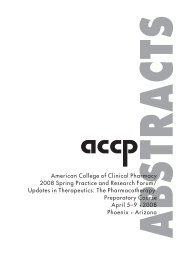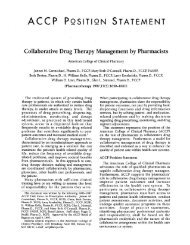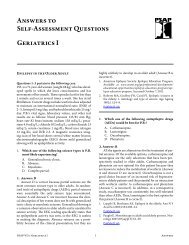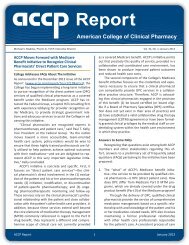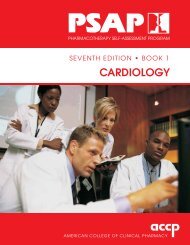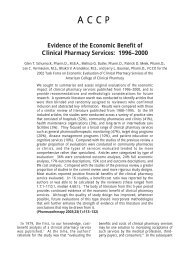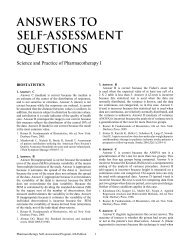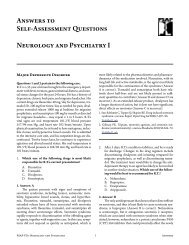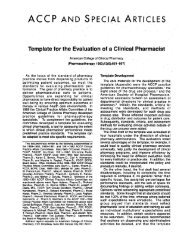Sample PDF - ACCP
Sample PDF - ACCP
Sample PDF - ACCP
Create successful ePaper yourself
Turn your PDF publications into a flip-book with our unique Google optimized e-Paper software.
B. Onabotulinum toxin A 200 units of<br />
intradetrusor injection.<br />
C. Mirabegron 25 mg daily.<br />
D. Duloxetine 20 mg twice daily.<br />
13. An 86-year-old man presents to the geriatrics clinic<br />
with new-onset dribbling and urinary urgency. His<br />
medical history includes osteoporosis, insomnia,<br />
depression, and type 2 diabetes mellitus. His home<br />
drugs include glipizide 5 mg twice daily, citalopram<br />
20 mg daily, diphenhydramine 50 mg at bedtime,<br />
alendronate 70 mg weekly, cholecalciferol 1000 units<br />
daily, simvastatin 10 mg daily, aspirin 81 mg daily, and<br />
loratadine 10 mg daily. His PVR in the clinic today<br />
is 310 cc. Recent laboratory test results include A1C<br />
7.5% and SCr 1.2 mg/dL. Which one of the following<br />
is best to recommend for this patient?<br />
A. Start tamsulosin 0.4 mg daily.<br />
B. Start tolterodine extended release 2 mg daily.<br />
C. Increase glipizide to 10 mg twice daily.<br />
D. Discontinue diphenhydramine 50 mg daily.<br />
14. A 69-year-old woman experiences urine loss when she<br />
coughs, sneezes, or lifts something heavy. She uses an<br />
incontinence pad for protection. She was started on<br />
estrogen 0.625 mg daily at menopause, but this was<br />
discontinued 5 years ago. Her medical history is significant<br />
for six vaginal deliveries, osteoarthritis,<br />
hypertension, and severe Alzheimer dementia. Her<br />
home drugs include acetaminophen 1000 mg twice<br />
daily and lisinopril 10 mg daily. Which one of the following<br />
is best to recommend for this patient’s UI?<br />
A. Pelvic muscle rehabilitation.<br />
B. Periurethral injection of a bulking agent.<br />
C. Duloxetine 40 mg twice daily.<br />
D. Conjugated estrogen 0.625 mg daily.<br />
Questions 15 and 16 pertain to the following case.<br />
B.K. is a 57-year-old woman (height 65 inches, weight<br />
64 kg) who has progressive difficulty with bladder control<br />
during the daytime. When she feels like she needs to<br />
use the toilet, she is sometimes unable to get to the bathroom<br />
on time. She has experienced a few “accidents” and<br />
is deeply embarrassed. When she exercises or coughs, she<br />
loses small amounts of urine. Her home drugs include<br />
alendronate 70 mg weekly for osteoporosis, loratadine 10<br />
mg daily for allergies, calcium carbonate 600 mg twice<br />
daily, vitamin D 1000 units daily, and ibuprofen 200 mg<br />
once daily for osteoarthritis. She is a lifelong smoker and<br />
does not drink alcohol. She consumes 1 cup of regular coffee<br />
with each meal. She complains of some osteoarthritis<br />
pain and her pain scale rating is 2/10.<br />
15. Which one of the following best explains B.K.’s symptoms<br />
of UI?<br />
A. Pedal edema caused by ibuprofen.<br />
B. Functional disability because of osteoarthritis.<br />
C. Decreased parasympathetic tone because of the<br />
aging process.<br />
D. Weakening of the pelvic floor musculature<br />
caused by loss of estrogen.<br />
16. Which one of the following is the best intervention to<br />
recommend for B.K.?<br />
A. Absorbent pads.<br />
B. Decaffeinated coffee.<br />
C. Weight loss.<br />
D. Fluid restriction.<br />
17. A 72-year-old woman (height 66 inches, weight 54 kg)<br />
receives a diagnosis of UUI. She lives with her spouse,<br />
who is retired. She is mildly cognitively impaired and<br />
has mild limitations in performing activities of daily<br />
living. Her home drugs include donepezil 10 mg at<br />
bedtime and memantine 10 mg twice daily for moderate<br />
Alzheimer disease, pravastatin 40 mg in the<br />
evening for hyperlipidemia, levothyroxine 75 mcg<br />
daily for hypothyroidism, sertraline 50 mg daily for<br />
depression, and metoprolol 25 mg twice daily for<br />
hypertension. She does not smoke or drink alcohol.<br />
She drinks only decaffeinated coffee. Which one of<br />
the following is best to recommend for this patient’s<br />
UUI?<br />
A. Discontinue donepezil 10 mg daily.<br />
B. Begin trospium 20 mg daily.<br />
C. Begin pelvic floor rehabilitation.<br />
D. Begin prompted toileting on a regular schedule.<br />
18. A 76-year-old woman (height 62 inches, weight 59 kg)<br />
with a diagnosis of SUI continues to have frequent episodes,<br />
despite attempts at pelvic floor rehabilitation<br />
with Kegel exercises. A pelvic examination reveals<br />
normal genitourinary anatomy. Her medical history<br />
is significant for hypertension, hyperlipidemia,<br />
insomnia, and chronic kidney insufficiency. Her<br />
home drugs include atorvastatin 40 mg daily, amlodipine<br />
10 mg daily, enteric-coated aspirin 81 mg daily,<br />
and calcium 600 mg/vitamin D 400 international<br />
units twice daily. Her blood pressure is 152/88 mm<br />
Hg, and her heart rate is 68 beats/minute. Her most<br />
recent laboratory results are as follows: TC 182 mg/<br />
dL, LDL cholesterol 111 mg/dL, sodium 135 mEq/L,<br />
chloride 101 mEq/L, potassium 3.8 mEq/L, serum<br />
glucose 88 mg/dL, and SCr 1.5 mg/dL. Which one of<br />
the following is best to recommend for this patient?<br />
A. Duloxetine 40 mg twice daily.<br />
B. Pessary placement.<br />
C. Sacral nerve stimulation.<br />
D. Midurethral sling.<br />
PSAP 2013 • Special Populations 18 Urinary Incontinence in the Older Adult





